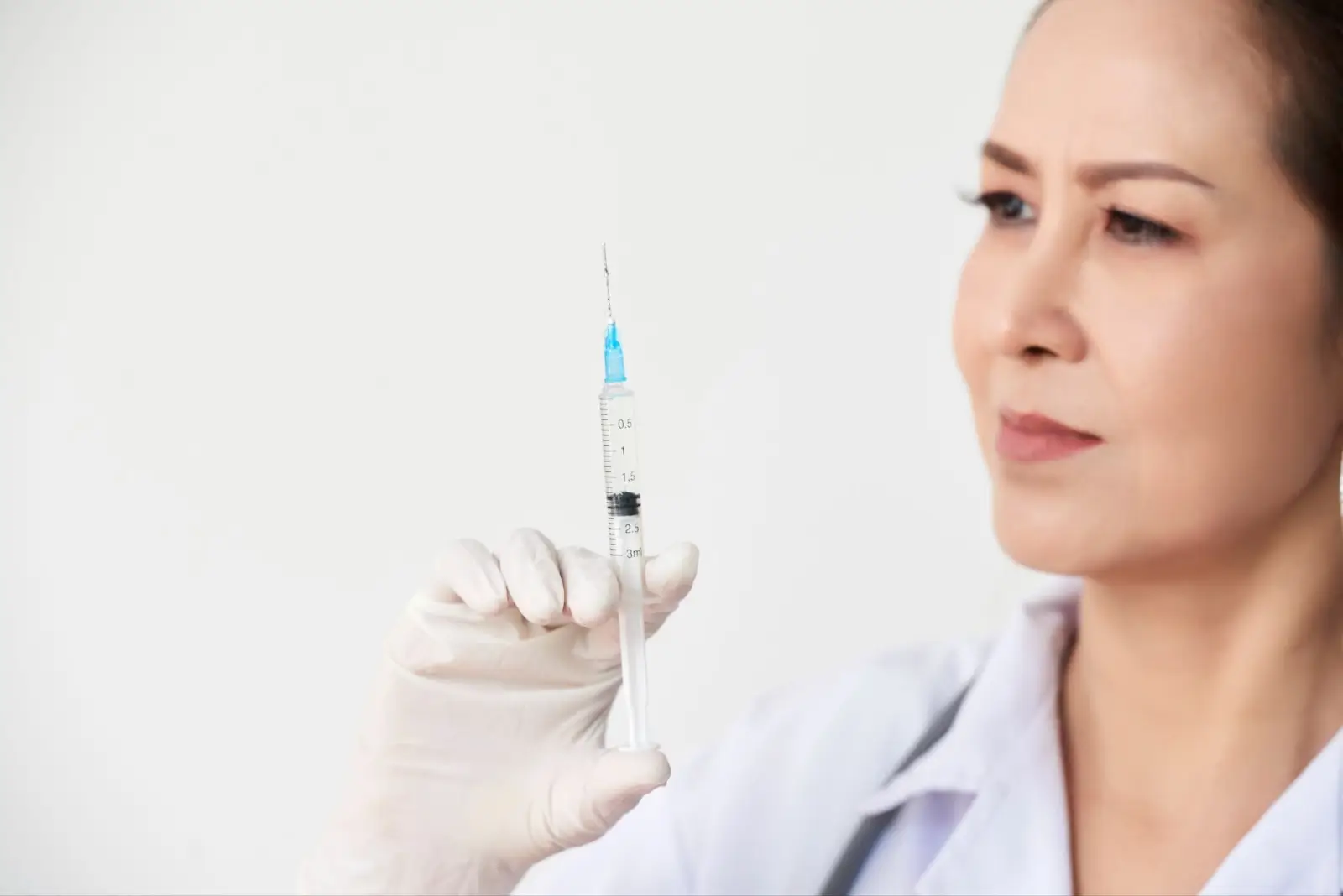
Vabysmo Side Effects – The Complete List
Vabysmo
2025-08-21
Explore the full range of Vabysmo (faricimab) side effects, from common issues like eye pain and conjunctival hemorrhage to rare but serious risks such as endophthalmitis and retinal detachment. Learn what to monitor and how to manage potential complications.
Joanna Carr
Intravitreal injections have transformed the way doctors manage retinal conditions, offering hope for diseases that once led to permanent vision loss. Still, they carry both minor and serious risks. A small blood spot on the eye (subconjunctival hemorrhage) occurs in up to 10% of cases and is usually harmless. More serious complications, such as endophthalmitis (a severe eye infection) or increased eye pressure—particularly with steroid-based therapies—are less common but can be sight-threatening.
Vabysmo® (faricimab-svoa) is a newer intravitreal drug that works by blocking both Ang-2 and VEGF-A. It is approved for wet age-related macular degeneration (nAMD) and diabetic macular edema (DME), with additional approvals for retinal vein occlusion in some regions. As its use expands, understanding both its common reactions, like temporary redness or discomfort, and its rare but serious complications is key to safe treatment.
In this article, we provide a complete breakdown of Vabysmo side effects—from the frequent and usually mild ocular reactions to the rare complications that require immediate attention. The goal is to help patients and practitioners know what to expect, what’s normal, and when to seek care.
Key Takeaways
- Vabysmo is generally well tolerated, with most patients only experiencing mild, short-lived side effects such as eye redness, discomfort, or blurred vision.
- Subconjunctival hemorrhage (7–8%), eye pain (5–6%), and floaters (2–3%) are among the most frequent minor events and usually resolve without treatment.
- Serious complications like endophthalmitis are very rare (<0.1% per injection), but patients should seek urgent care for symptoms like sudden vision loss, flashes of light, or severe eye pain.
- Transient eye pressure spikes are common after all intravitreal injections, but long-term pressure increases are uncommon with Vabysmo.
- Systemic risks are minimal and not higher than with other anti-VEGF therapies, though caution is advised in patients with recent stroke or heart disease.
- Close monitoring, patient education, and early reporting of symptoms are essential to safe and effective treatment.
About: Doctor Medica is your trusted supplier of top-quality dermal fillers, viscosupplements, and more for your medical practice. We offer genuine products from leading brands at the lowest prices in the market. If you’re looking to order Vabysmo online for your practice, contact Doctor Medica today.
Common Vabysmo Side Effects After Intravitreal Injection

Most patients tolerate Vabysmo (faricimab-svoa) well, and the most common side effects usually resolve within a few days. These effects often reflect the procedure itself rather than the drug’s specific action.
In clinical trials, subconjunctival hemorrhage (a small red spot on the eye surface) occurred in about 7–8% of patients, while mild eye pain or discomfort was seen in 5–6%. Less frequent events included vitreous floaters (2–3%) and short-lived blurred vision.
Doctors often reassure patients that these reactions are expected and temporary. While they may affect reading, driving, or other daily activities, they rarely indicate lasting harm. Supportive care, like artificial tears or simply resting the eye, can help relieve discomfort. Patients are advised to avoid rubbing the treated eye to minimize irritation. If symptoms persist beyond a few days or worsen, an ophthalmologist should be consulted to rule out complications.
Common Side Effects
- Mild eye pain or discomfort at the injection site
- Subconjunctival hemorrhage (small red spot on the eye)
- Transient blurred vision
- Vitreous floaters
- Increased tearing or irritation
- Photophobia (light sensitivity) shortly after injection
Serious Ocular Risks Associated with Vabysmo
Although rare, serious ocular risks can occur and require immediate medical attention. In clinical trials of Vabysmo, the rate of endophthalmitis (a severe intraocular infection) was <0.1% per injection, much lower than the broader 0.02–1.6% range often quoted for all intravitreal drugs. Other rare risks include retinal detachment or tears, significant intraocular inflammation, and sustained elevations in intraocular pressure (IOP).
It’s important to distinguish between transient and sustained IOP changes. Transient IOP spikes are common after all intravitreal injections and usually resolve within minutes to hours, while long-term IOP elevation is uncommon with anti-VEGF agents like faricimab. Still, close follow-up is necessary to detect these changes early.
Serious Ocular Risks
- Endophthalmitis (severe eye infection)
- Retinal detachment or tear
- Significant intraocular inflammation
- Increased intraocular pressure
- Severe vision loss or sudden changes in sight
Patients should be counseled on warning signs, including worsening eye pain, flashes of light, new floaters, sudden vision loss, or spreading redness, and told to seek urgent care if these appear. Careful sterile technique during injection and structured follow-up visits help minimize these rare but potentially devastating complications.
Systemic Side Effects of Vabysmo: What Clinicians Should Know
Because Vabysmo is injected directly into the eye, systemic absorption is low compared to oral or intravenous therapies. However, systemic safety remains an important consideration, particularly in patients with cardiovascular disease.
In trials, the incidence of arterial thromboembolic events (ATEs) such as stroke or myocardial infarction was low and not statistically higher than with other anti-VEGF therapies. Even so, providers often exercise caution in patients with a recent history of stroke or heart attack.
Other possible systemic effects include blood pressure fluctuations and very rare cases of systemic hypersensitivity reactions. Some patients have reported a sense of fatigue or malaise after injection visits, although this is not a consistently documented side effect in large-scale trials and may reflect the stress of repeated medical procedures rather than the drug itself.
Possible Systemic Side Effects
- Rare arterial thromboembolic events (stroke, heart attack)
- Hypertension or blood pressure changes
- Rare systemic hypersensitivity reactions
- Anecdotal fatigue or malaise after visits
Providers are encouraged to maintain awareness of systemic risks, even if uncommon, and to collaborate with primary care physicians or cardiologists when treating patients with significant comorbidities. This careful approach strengthens patient safety without undermining the overall benefit–risk balance, which remains favorable.
Monitoring and Managing Vabysmo Side Effects in Practice

The management of Vabysmo side effects goes beyond the day of the injection. Since complications can arise days or even weeks later, structured monitoring protocols are vital. Ophthalmologists usually schedule early follow-up visits to assess retinal health, check for infection or inflammation, and measure eye pressure. Ongoing vigilance is key, particularly for patients on long-term treatment.
Key Management Strategies
- Routine Eye Examinations: Early post-injection follow-ups help detect complications before they cause permanent vision loss.
- Immediate Intervention: Prompt action for suspected infection, retinal detachment, or vascular occlusion prevents irreversible harm.
- Comprehensive Patient Education: Teaching patients to recognize signs like redness, swelling, or floaters encourages timely reporting.
- Multidisciplinary Coordination: Collaborating with cardiologists or internists helps address systemic risks in patients with vascular disease.
- Flexible Treatment Intervals: Dosing schedules may be adjusted if patients experience recurrent side effects, balancing efficacy with safety.
Since Vabysmo’s FDA approval, global use has expanded rapidly, making consistent monitoring protocols even more critical. The best outcomes depend on a team-based approach where providers, patients, and families all play a role in safety. This proactive model helps maximize the benefits of Vabysmo while reducing risks.
Conclusion
Vabysmo represents a major step forward in retinal care, offering dual-pathway targeting and extended dosing intervals that improve convenience without compromising outcomes. Still, no therapy is without risk. Understanding both the common short-lived side effects and the rare but serious complications allows patients and providers to approach treatment with confidence and realistic expectations.
With vigilant monitoring, clear education, and early reporting of concerning symptoms, most side effects are either preventable or manageable. For patients considering therapy, transparency about risks and benefits builds trust and supports shared decision-making. Ultimately, the goal of Vabysmo treatment is not just clearer vision today, but long-term preservation of sight and quality of life.
FAQs
1. What are the most common Vabysmo side effects?
The most common include mild eye pain, redness, subconjunctival hemorrhage (7–8%), and temporary blurred vision. Vitreous floaters (2–3%) also occur in some patients. These generally resolve within days.
2. Can Vabysmo cause systemic side effects?
Systemic risks are very rare. Potential concerns include arterial thromboembolic events and hypertension, though rates are not higher than with other anti-VEGF therapies. Providers review cardiovascular history before starting treatment.
3. How can serious side effects be prevented?
Strict sterile technique, structured follow-up visits, and patient education are the best preventive measures. Early reporting of symptoms like pain, vision loss, or increasing redness allows rapid treatment and protects long-term vision.
References
Fleissig E, Loewenstein A. Complications of Intravitreal Injections. Retinal Physician. April 2022. https://retinalphysician.com/issues/2022/april/complications-of-intravitreal-injections/
Genentech. VABYSMO Phonetic video. Vabysmo. https://www.vabysmo.com/wamd/safety/side-effects.htmlRamos MS, Xu LT, Singuri S, et al. Patient-Reported Complications after Intravitreal Injection and Their Predictive Factors. Ophthalmol Retina. 2021;5(7):625-632. doi:10.1016/j.oret.2020.09.024
Related Articles
Joanna Carr
Botox Vs. Dysport
Interested to learn more about Botox Vs. Dysport? Browse Doctor Medica's comprehensive listing of blog posts.
Joanna Carr
EMLA vs LET – Clinical Effectiveness Compared
Compare the efficacy, onset time, and use-case scenarios of EMLA and LET creams to determine the best option for your specific needs.
Joanna Carr
What Is Remicade and How Does It Work?
Discover what Remicade is, how it works to treat autoimmune diseases like Crohn’s disease and rheumatoid arthritis, and the science behind its immune ...


